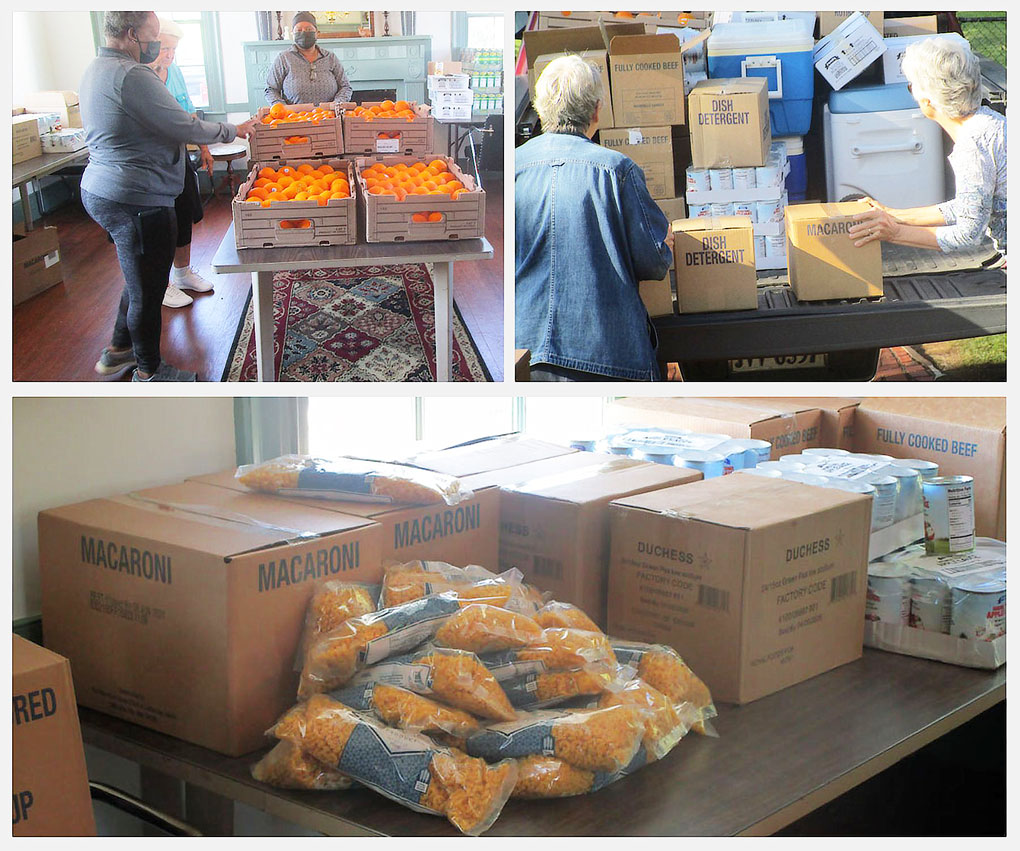
2023 Sun Oct 1
“Tens” Stewardship Commentary, Oct. 1, 2023
Click here to view in a new window.
Village Harvest at the end of the third quarter, Sept, 2023

The 3rd quarter Harvest trends, 2023 were consistent with the 2nd quarter (April-June) in people served but well above in food provided. This brought the pounds per person ratio down.
September is the end of the 3rd quarter. During the 3rd quarter (July through Sept) we served the same number of clients – 262 as the second quarter (April-June). It was above both 2022 and 2021 3rd quarter and 2nd – 251 and 257, respectively.
Food provided at 3,654 pounds was much higher in the third quarter 2023 than the second, 3,457. 3,654 in 2023 for the 3rd quarter was higher than 2022 3,258 and 2021 3,312, respectively as well.
The year-to-date for 2023 remains below 2022 and 2021. This was due to the low numbers of clients in the first quarter 2023. We served 218 in the first quarter 2023 compared to 296 in 2022 and 295 in 2021. Second and third quarter were much better so the analysis favors an interim approach.
World Communion Sunday, Oct. 1

What is World Communion Sunday? Churches this Sunday all over the world celebrate oneness in Christ in the midst of the world ever more in need of peacemaking and the universal and inclusive nature of the church. The tradition originated in the Shadyside Presbyterian Church in 1933, was adopted throughout the US Presbyterian Church in 1936, and subsequently spread to other denominations. The Episcopal Church also remembers students serving abroad, particularly the Young Adult Service Corp in the Episcopal Church.
Poem for World Communion Sunday
THE TABLE WITH NO EDGES by Andrew King
We will sit down where feet tire from the journey.
We will sit down where grief bends the back.
We will sit down under roofs wrecked by artillery.
We will sit down where cries sound from cracked walls.
We will sit down where heat beats like hammers.
We will sit down where flesh shivers in cold.
We will sit down where bread bakes on thin charcoal.
We will sit down where there is no grain in baked fields.
We will sit down with those who dwell in ashes.
We will sit down in shadow and in light.
We will sit down, making friends out of strangers.
We will sit down, our cup filled with new wine.
We will sit down and let love flow like language.We will sit together at the table with no edges.
We will sit to share one loaf, in Christ’s name, in one world.
Recent Articles, Sun. Oct. 1, 2023
Lectionary for Pentecost 18
Commentary Oct. 1
Vanderbilt visual commentary
Stewardship Commentary
World Communion Sunday
ECW Donation & Planning meeting
Season of Creation ends Oct. 4
Season of Creation retrospective
Visual Eucharistic Prayer
5 areas of the Environment in the Season of Creation
Part 5 – Deforestation
Prayers ending the Season
Remembering St. Francis…
All About St. Francis, Oct. 4
“God’s Garden makes pet blessings
St. Francis in the Christmas Play in 2015
Richard Rohr on St. Francis
Mission and Outreach
Village Harvest Review Sept 30
Donations for Maui
Jamaican mission school distribution, Aug. 26, 2023
Sept., 2023 newsletter
Season of Creation 2023 – a retrospective

The image shows the challenges and work to improve the environment in the darker areas with the light areas, the work we are doing now and a promise for the future.
We did fewer projects and concentrated on the beauty of creation and the need for renewal. The Season of Creation was present in these areas:
- Five Sundays readings in the Season of Creation and highlighted a specific environmental area which we covered weekly.- Earth, water, energy, food (waste), deforestation. Link
- We began a new Christian Ed for Children ages 5-9 and they covered water
- The services during the month had the following different sections
Sunday Links, Oct. 1, Pentecost 18, Season of Creation V
Lector: Cookie Davis
Chalice Bearer: Andrea Pogue
Altar Cleanup: Jan Saylor
Lectionary Pentecost 18, Proper 21, Year A, Oct 1, 2023
I.Theme – Look carefully at the vineyard you are cultivating!

"Vineyards with view of Auvers" – Van Gogh (1890)
The lectionary readings are here or individually:
Old Testament – Isaiah 5:1-7
Psalm – Psalm 80:7-14 Page 703, BCP
Epistle –Philippians 3:4b-14
Gospel – Matthew 21:33-46
The main motif in 3 of the 4 readings is about the vineyard which beginning in the Old Testament refers to Israel and by the Gospel to those tending it. Corruption is evident in Israel in the 8th Century BC and in 30AD with Christ. In Christ time the vineyard represents all places where we have been called by God to produce the fruits of the kingdom. The real villains move from Israel as a country to specific groups cited by Matthew.
The Isaiah reading is one of the oldest parables in the Bible. This song of the vineyard is a parable and a prophetic attack on corrupt Israel. It begins as a love song, singing of a deep love that is giving and caring, moves on to convey disillusionment, and then to express anger and a withdrawal of love and care. The coming destruction (verses 5-6) results from the people’s failure to do what God "expected," and more literally and poignantly, what God "hoped for" (verses 2, 4, 7). God doesn’t destroy the vineyard directly. Instead, what he described was simply the removal of his care and protection of the vineyard, the careful work done earlier.
ECW Planning and Donation meeting, Sept. 25, 2023

The September meeting of the St. Peter’s ECW was held at the Heimbachs’ house because tree work at the church made parking limited. There were about 11 in attendance. Typically the ECW (Episcopal Church Women) at St. Peter’s give half of their earnings away by the 4th quarter of each year for outreach.
After everyone enjoyed tea and snacks, we welcomed our new member, Jean Devitt. Then, Elizabeth reported that the ECW account currently totaled $2280.89, and the group agreed to donate $100 to CERVE, (the Caroline Emergency Relief through Volunteer Efforts), $250 to Catherine’s Discretionary Fund, $500 to Village Harvest, and $500 to Social Services for their Christmas program. Since an anonymous member had given an additional $70, the ECW account will have $1000 after these donations are made.
Nancy Long has agreed to do some research to find out about the cost of repairing the brass altar vases which were a gift to St. Peter’s from the ECW, while Alice said that she would try to find out the possible value of the large bas-relief currently stored upstairs in the rectory.
The group also discussed plans for the coming months including a visit to Chancellor’s Village, and a tour of the Potowomack Center. In addition, we talked about providing refreshments for the Epiphany and Presentation Services when the St. Peter’s Choir will join the choir of St. Asaph’s. We also agreed to prepare dinner for the Episcopalian students at Mary Washington, and, perhaps, to supply snacks for them during exam week in early December.
Finally, several people had ideas for events for which we could sell tickets to raise money. Jan suggested a Mother’s Day brunch, Catherine suggested a croquet match, and several people talked about the possibility of an event like a concert that could include a barbecue.
Season of Creation – Forests (Deforestation)
This week we look at ground level to consider deforestation
Deforestation
Forests in our memories – From Michelle Cook, Intergen. “How do you think of forests? In your imagination are they places of peace and quiet? Are they places that scare you? Are you more at home in a eucalypt forest than in a mangrove forest? Sometimes forests can be places of fear. Think of all the old stories from Europe, the folk tales some of us may have grown up hearing. Stories like Hansel and Gretel, where children get lost in the forest. Stories like Snow White, where the beautiful young girl gets taken to the forest by the hunter so that he may kill her far away from witnesses. Forests in these stories are seen as places of secrecy, of unknown dangers and mysterious powers.”
“In Psalm 139 it is our bodies being knit together in our mother’s wombs that becomes known. God, the creator of everything, knows our bodies, and hear the Psalmist says to us that we are fearfully and wonderfully made. Even the workings of the womb, hidden from us, and felt by mothers, are known by God. The story of creation is retold in Genesis 2:4b-22. Adam is created from earth and is set in a garden – a forest of fruit trees – a garden of food. Here is a forest, where again, all is known. The chaos and desperation of the land, where nothing is yet growing, is contrasted with the richness and safety of the garden.”
